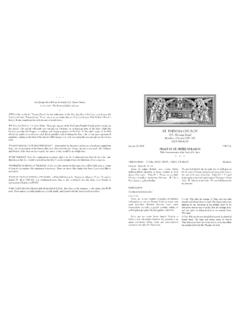Transcription of A Very Simple Guide to the Catholic Mass
1 A Very Simple Guide to the Catholic mass Text from the Third Edition of the Roman Missal by R. J. Grigaitis, This document is licensed under a Creative Commons License. You are free to use it for non-commercial purposes providing appropriate credit is given to R. J. Grigaitis. Excerpts from the Third Edition of The Roman Missal International Committee on English in the Liturgy, Inc. Why do Catholics bounce on one knee? Introduction Are you about to attend a Catholic mass for the first time? Maybe you haven't been to mass for a long time and can't remember what to do. Well, guess what, there's been some changes to the mass , so you're in the same boat as everyone else. Like everyone else, you need to learn how the new English translation of the mass goes, so I've written this Guide just for you.
2 Whether you're going to mass for the first time, haven't been for a long time, or have been going very regularly, it's wonderful that you're attending mass . To help you enjoy and understand the mass , without looking like you don't know what you're doing, I'm going to give you a play- by-play of what's said and what's going on. I get into a few details, but I. can't go into everything without this booklet getting too long. First of all, you may be wondering why the mass has changed. The mass really hasn't changed much since the early 70s. What has changed is the English translation to reflect more accurately the Latin text. The Latin text I'm referring to is not the Latin mass that was said before the 70s, but the new mass of the 70s.
3 It was written in Latin, and then translated into all the different languages throughout the world. It's this translating that has been redone, and now we have to relearn the English mass . By the way, the Latin mass that was said before the 1970s is called the Tridentine mass because it was part of the liturgical reform of the Council of Trent in the 16th century. (It's sometimes referred to as the Traditional Latin mass . ) The new mass is called the Novus Ordo (see, it really is Latin), and it came out of the liturgical reform of the Second Vatican Council in the 1960s. The new mass is adapted from the Tridentine mass . If you get an opportunity to go to a Tridentine mass , I. highly recommend it to get a better appreciation of the new mass .
4 Since Latin is still the official language of the Roman Church and the original text of the new mass is written in Latin, it's good to know how to say, or better yet chant, some parts of the mass in Latin. In fact, the Second Vatican Council mandates that the faithful can say or sing together in Latin those parts of the Ordinary of the mass that concerns them. 1 For this reason, I'm going to give you some of the Latin text in this Guide . Another mass I highly recommend is the mass of the Eastern Churches;. although, they don't call it mass , but Divine Liturgy. If you go to a Divine Liturgy in an Eastern Catholic church, you can receive Communion and it satisfies your Sunday obligation. However, if you go to a Divine 1 Cf.
5 Sacrosanctum Concilium 54. Draft: 2010-12-14 page 1 of 26. Why do Catholics bounce on one knee? Liturgy in an Eastern Orthodox church, you should not receive Communion because, although all their sacraments are valid and the liturgy is identical, we are not yet in full communion with each other. Some of the new translation of the English Roman mass is similar to the English translation of the Eastern Divine Liturgy. The Eastern Churches have always had Divine Liturgy in the language of the people (technically call the vernacular ), while the Roman Church has only had mass in the vernacular since the reforms of the Second Vatican Council in the 60s. Occasionally, I'll mention the Eastern Churches in this Guide .
6 While I'm making recommendations, if you have an opportunity to go to a Jewish synagogue service, it also gives a better appreciation of the mass . After all, Catholicism and the mass are really just the fulfilment of the Jewish religion and an adaptation of the synagogue service. Needless to say, this wouldn't fulfill your Sunday obligation, so if you go to a synagogue Saturday morning, you still have to go to church on Sunday. I've mentioned the Sunday obligation a couple of times now. You may not know this, but Catholics are required to go to Sunday mass every week unless excused for a serious reason. 2 A Sunday mass can be said on a Saturday evening as well as on a Sunday, and attending either one will fulfil your Sunday obligation.
7 However, a mass on a Saturday morning or afternoon will not be a Sunday mass but a weekday mass and will not fulfil your Sunday obligation. It's up to your local bishop as to how early in the day a Sunday mass can be said on a Saturday, but usually it's around 5:00. pm. If you didn't know this, don't worry; just start going to Sunday mass . Did you catch that part about weekday mass ? There's mass on weekdays too. They're similar to Sunday Masses except they usually don't have a second reading, and some parts are optional; like the homily. Another thing you may not know is that you're supposed to fast for an hour before receiving This fast consists of not eating and drinking anything except water and medicine.
8 Eastern Christians have to fast even longer. Their fast starts an hour before the beginning of Divine Liturgy. I heard on Eastern priest joke during a homily once that if they had the same fasting rule as the Roman Church, they could probably bring a sandwich to Divine Liturgy and eat it as Divine Liturgy starts because Divine Liturgy is so long. I'm starting to give too much detail now, and I really want to keep this booklet as short as possible. However to keep you fully aware of what's 2 Catechism of the Catholic Church 2181. 3 Code of Canon Law 919 1. Draft: 2010-12-14 page 2 of 26. Why do Catholics bounce on one knee? going on, most of the words the priest or a helper says are given, and all the words you'll have to say are given.
9 Words like this are what the priest or a helper says. Words like this are what you and everyone else says. Sometimes the priest mumbles to himself. He's supposed to do this. Sometimes the priest is supposed to say things inaudibly. Some priests say it in their head, some mumble, and some say it just loud enough to hear. I'm also going to give you these words to you in this Guide . I mentioned that there are people helping the priest during mass . One of these helpers can possibly be a deacon. A deacon can do some of the things a priest can do, but not everything a priest can do. You can tell the difference between a priest and a deacon by the way they wear their stole. The stole is the strip of fabric that a priest wears around the back of his neck and hangs down the front.
10 A deacon also wears a stole, but he wears it over his left shoulder drawn diagonally across his chest and fastened at his right hip. Now, on with the Entering a Catholic Church The first thing you'll see people doing is dipping their finger in some water and then crossing themselves. This water has been blessed by a priest or deacon, and is called holy water. When people bless themselves with holy water, they are remembering their baptism. Making the sign of the cross is done quite often by Catholics, so you should make sure you know how to do this. First, you touch your forehead with a finger of your right hand, saying, In the name of the Father, then touch your lower chest, saying, the Son, next touch your left shoulder, saying, and the Holy, and finally touch your right shoulder, saying, Spirit.

